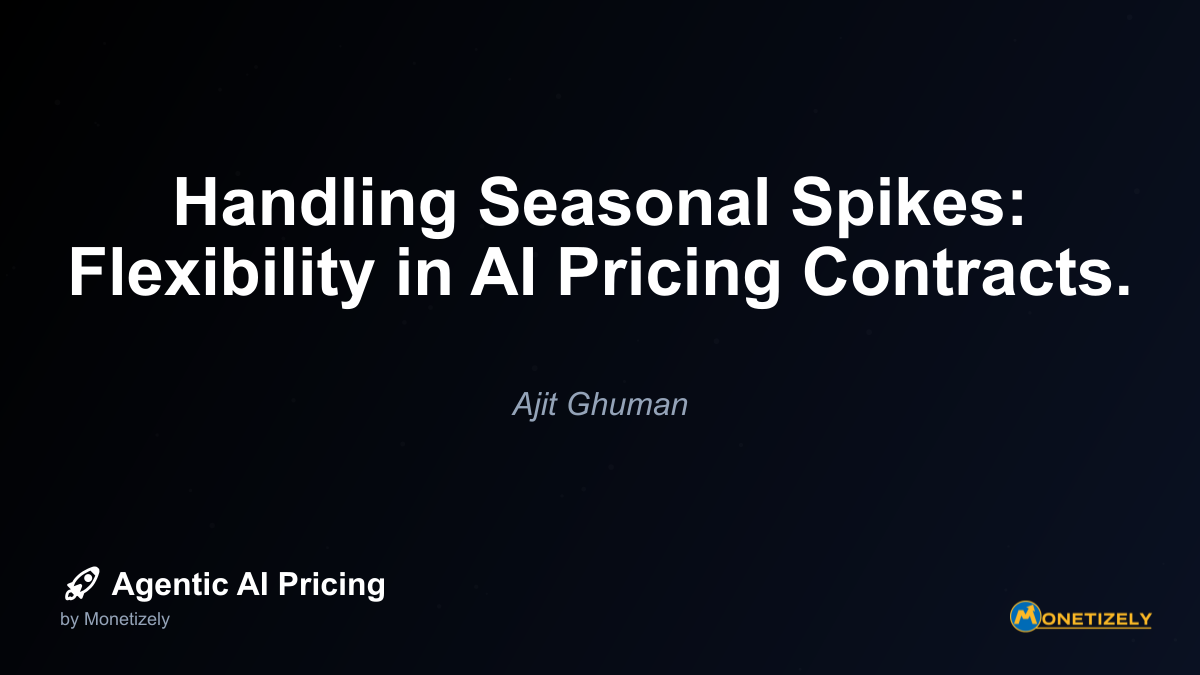· Ajit Ghuman · Strategy & Planning · 9 min read
Handling Seasonal Spikes: Flexibility in AI Pricing Contracts.
AI and SaaS Pricing Masterclass
Learn the art of strategic pricing directly from industry experts. Our comprehensive course provides frameworks and methodologies for optimizing your pricing strategy in the evolving AI landscape. Earn a professional certification that can be imported directly to your LinkedIn profile.

A major retail company implemented an AI-powered customer service chatbot with a standard fixed-capacity contract. During normal operations, the system handled approximately 50,000 customer inquiries per day. However, during the six-week holiday shopping period, volume surged to over 200,000 daily inquiries.
The company faced a difficult decision:
- Purchase capacity for 200,000 daily inquiries year-round (wasting 75% of capacity for 46 weeks)
- Accept significant performance degradation during their most critical sales period
- Pay enormous overage charges during the holiday season
This scenario illustrates the fundamental mismatch between traditional pricing models and the reality of seasonal business operations. As highlighted in research on seasonal AI pricing strategies, businesses need contract structures that align with their natural operational rhythms.
Flexible Contract Structures for Seasonal AI Usage
Several innovative contract approaches can address seasonal fluctuations while balancing the needs of both customers and AI providers:
1. Dynamic Usage Tiers
Rather than imposing fixed capacity limits, dynamic tier systems adjust based on usage patterns:
Automatic Tier Adjustment Contracts can include provisions that automatically adjust pricing tiers based on actual usage patterns. For instance, a customer might normally operate within a “Standard” tier, but automatically upgrade to “Premium” during peak periods, then revert afterward without manual intervention.
Blended Rate Calculations Some providers implement blended rates that effectively average costs across high and low-usage periods. This approach provides budget predictability for customers while accommodating natural usage fluctuations.
Example Implementation:
Standard Tier: Up to 50,000 daily interactions at $0.05 per interaction
Peak Tier: 50,001-200,000 daily interactions at $0.03 per interaction
Automatic tier adjustment based on 7-day rolling average usageThis structure rewards customers with volume discounts during peak periods while maintaining reasonable baseline pricing.
2. Usage Credit Systems
Credit-based systems provide flexibility through various mechanisms:
Rollover Credits Similar to mobile phone data plans, AI contracts can allow unused capacity credits to roll over for a specified period. This approach enables customers to “bank” capacity during low-usage periods for use during seasonal spikes.
Prepaid Credit Pools Some providers offer discounted credits purchased in advance that can be drawn down at variable rates throughout the year. This approach provides cost savings for customers while giving providers upfront revenue.
Expiration Flexibility Traditional credits often expire after 30 days. Extending expiration periods to 90, 180, or 365 days allows businesses to manage seasonal patterns more effectively.
Example Implementation:
Annual package: 12 million interactions at $0.04 each ($480,000 total)
Credits valid for 18 months from purchase
Minimum monthly usage: 500,000 interactions
Usage flexibility: Up to 2 million interactions in any single monthThis structure provides significant flexibility while ensuring minimum revenue for the provider.
3. On-Demand Capacity Scaling
Some contracts focus on enabling rapid scaling during peak periods:
Burst Capacity Provisions Contracts can include predefined “burst capacity” that becomes available on demand. This capacity might carry premium pricing but ensures availability during critical periods.
Reserved Capacity Options Similar to AWS Reserved Instances, customers can reserve additional capacity for specific future periods at discounted rates compared to on-demand pricing.
Hybrid Commitment Models These approaches combine base commitments with flexible on-demand components, providing predictable baseline costs with the ability to scale.
Example Implementation:
Base commitment: 50,000 daily interactions at $0.05 each
Reserved holiday capacity: Additional 100,000 daily interactions at $0.04 each
(must be reserved 60 days in advance)
On-demand capacity: Additional interactions at $0.08 each (subject to availability)This model provides cost certainty for predictable seasonal patterns while offering flexibility for unexpected spikes.
4. Seasonal Contract Adjustments
Some providers offer explicit seasonal provisions:
Predefined Seasonal Periods Contracts can formally define peak periods with different terms, providing clarity and predictability for both parties.
Temporary Tier Upgrades Customers can schedule temporary upgrades to higher service tiers during known peak periods, often at discounted rates compared to standard tier pricing.
Contract Pause Options For highly seasonal businesses, some providers offer the ability to partially pause or reduce services during extreme low-usage periods.
Example Implementation:
Standard period (Feb-Oct): 50,000 daily interactions at $0.05 each
Holiday period (Nov-Jan): 200,000 daily interactions at $0.035 each
Annual contract value: $912,500 ($75,000 monthly during standard period, $215,833 monthly during holiday period)This approach aligns contract terms with known business cycles, benefiting both parties.
Implementation Considerations for Flexible AI Pricing
While flexible pricing models offer significant advantages, successful implementation requires careful consideration of several factors:
Data Requirements
Effective seasonal pricing requires robust usage data:
- Historical Pattern Analysis: At least 12-24 months of historical data helps identify true seasonal patterns versus anomalies.
- Granular Usage Metrics: Data should be sufficiently detailed to distinguish between different usage types and user segments.
- Forecasting Capabilities: Both providers and customers need reasonable forecasting tools to predict future usage patterns.
Contract Complexity Balance
Flexible contracts inherently involve more complexity:
- Simplicity vs. Flexibility Tradeoff: Extremely customized contracts may optimize for specific usage patterns but become difficult to understand and administer.
- Clear Documentation: Terms should be clearly documented with examples illustrating how different usage scenarios affect pricing.
- Educational Resources: Providers should offer calculators, dashboards, and other tools to help customers understand and optimize their usage.
Technical Implementation Requirements
Supporting flexible pricing requires specific technical capabilities:
- Real-Time Usage Monitoring: Systems must track usage continuously to enable dynamic tier adjustments.
- Automated Billing Systems: Backend systems need to accommodate complex pricing rules and usage calculations.
- Customer-Facing Dashboards: Transparent reporting helps customers understand their usage patterns and optimize their approach.
Cost Structure Alignment
Providers must ensure flexible pricing aligns with their cost structure:
- Infrastructure Capacity Planning: Providers must balance flexibility with their need to plan infrastructure investments.
- Risk Premium Considerations: Truly unpredictable usage patterns may warrant risk premiums in pricing.
- Long-Term Revenue Stability: Flexible models should still provide sufficient revenue predictability for business planning.
Case Studies: Successful Seasonal AI Pricing Approaches
Enterprise CRM Provider: Seasonal Credit System
A major CRM platform offering AI-powered sales intelligence implemented a credit-based system with 12-month validity. Customers purchase annual credit pools with minimum monthly usage requirements but substantial flexibility for seasonal allocation.
Results:
- 28% increase in customer satisfaction scores
- 15% reduction in contract negotiation cycles
- 22% increase in average contract value due to customers’ willingness to commit to larger credit pools given the flexibility
Retail Chatbot Provider: Dynamic Tier Model
A specialized retail chatbot provider implemented automatic tier adjustments based on 30-day rolling averages, with volume discounts that increase during high-usage periods.
Results:
- 35% reduction in customer churn
- 40% increase in holiday season capacity utilization
- 18% improvement in gross margin through more efficient capacity planning
Financial Analysis Platform: Reserved Capacity Approach
A financial AI platform that experiences predictable quarterly spikes implemented a reserved capacity model allowing customers to pre-book additional capacity for known reporting periods.
Results:
- 45% reduction in performance-related support tickets during peak periods
- 30% increase in customer expansion revenue
- 25% improvement in infrastructure utilization efficiency
Future Trends in Seasonal AI Pricing
Several emerging trends are likely to shape the future of seasonal AI pricing:
AI-Powered Pricing Optimization
The same machine learning capabilities powering AI solutions can be applied to pricing optimization:
- Predictive Usage Modeling: AI can analyze usage patterns to recommend optimal contract structures.
- Dynamic Price Optimization: Systems can automatically adjust pricing parameters based on changing usage patterns.
- Personalized Contract Recommendations: AI can suggest custom contract structures optimized for each customer’s specific usage patterns.
Outcome-Based Seasonal Adjustments
Some providers are beginning to combine seasonal flexibility with outcome-based pricing:
- Value-Adjusted Seasonal Pricing: Pricing adjusts based not just on volume but on the changing value of AI during different seasons.
- Performance Guarantees: Contracts include seasonal performance SLAs with financial implications.
- Success-Based Components: Pricing includes components tied to seasonal business outcomes rather than just usage metrics.
Marketplace and Exchange Models
New models are emerging that treat AI capacity as a tradable resource:
- Capacity Exchange Platforms: Systems allowing organizations to buy, sell, or trade AI capacity rights.
- Futures and Options: Financial instruments giving the right to purchase AI capacity at predetermined prices.
- Dynamic Spot Markets: Real-time marketplaces where excess AI capacity is sold at variable rates based on current supply and demand.
Industry-Specific Solutions
As the market matures, expect more specialized solutions for different sectors:
- Retail-Specific Contracts: Designed specifically around holiday shopping patterns.
- Financial Services Packages: Optimized for quarterly reporting cycles.
- Healthcare Solutions: Structured around seasonal health patterns and insurance cycles.
Implementing Flexible Seasonal Contracts: A Practical Framework
For organizations looking to implement or negotiate seasonal AI contracts, the following framework provides a structured approach:
1. Usage Pattern Analysis
Begin by thoroughly analyzing historical and projected usage patterns:
- Identify Seasonality: Distinguish true seasonal patterns from random fluctuations or growth trends.
- Quantify Variations: Measure the magnitude of seasonal spikes relative to baseline usage.
- Map Business Drivers: Connect usage patterns to underlying business activities and calendar events.
2. Contract Structure Selection
Based on usage patterns, select the most appropriate contract structure:
- High Predictability: Predefined seasonal periods with different pricing tiers.
- Moderate Predictability: Credit-based systems with extended validity periods.
- Low Predictability: Dynamic tier systems with automatic adjustments.
- Mixed Patterns: Hybrid approaches combining multiple elements.
3. Financial Modeling
Model the financial implications of different approaches:
- Total Cost Comparison: Compare total annual costs under different contract structures.
- Cash Flow Impact: Analyze how different payment structures affect cash flow throughout the year.
- Risk Assessment: Evaluate the financial risk of unexpected usage variations under each model.
4. Implementation Planning
Develop a comprehensive implementation plan:
- System Requirements: Identify necessary technical capabilities for monitoring and billing.
- Transition Strategy: Plan the transition from existing contracts to new flexible structures.
- Education Program: Develop materials to help stakeholders understand the new approach.
5. Ongoing Optimization
Establish processes for continuous improvement:
- Regular Reviews: Schedule periodic reviews of actual usage against projections.
- Contract Adjustments: Define clear processes for adjusting contract parameters based on changing patterns.
- Feedback Loops: Create mechanisms to capture stakeholder feedback on contract effectiveness.
Negotiation Strategies for Seasonal AI Contracts
Whether you’re a provider offering flexible contracts or a customer seeking better terms, these negotiation strategies can help achieve mutually beneficial outcomes:
For AI Providers:
- Emphasize Total Value: Focus discussions on the total annual value rather than peak capacity costs.
- Highlight Infrastructure Investment: Explain how flexible contracts help fund the infrastructure necessary for peak performance.
- Offer Graduated Options: Present multiple flexibility options at different price points.
- Demonstrate Cost Savings: Show customers how flexible contracts reduce their total cost compared to fixed alternatives.
For AI Customers:
- Share Usage Data: Provide detailed historical usage data to justify seasonal provisions.
- Bundle Seasonal Needs: Combine requirements from multiple departments to increase negotiating leverage.
- Commit to Longer Terms: Offer longer contract durations in exchange for seasonal flexibility.
- Start with Pilots: Begin with limited-scope implementations to demonstrate the value of flexible approaches.
Conclusion: Transforming Seasonality from Challenge to Opportunity
Seasonal fluctuations in AI usage don’t need to create tension between providers and customers. With thoughtfully designed contract structures, seasonality can become an opportunity to deliver greater value while building stronger business relationships.
Flexible pricing approaches—whether through dynamic tiers, credit systems, capacity reservations, or explicit seasonal provisions—enable both parties to achieve their objectives. Customers gain the capacity they need during critical periods without overpaying year-round, while providers can plan infrastructure investments with greater confidence and achieve more predictable revenue streams.
As AI continues to become more deeply embedded in business operations, the ability to accommodate natural business rhythms in pricing and contracts will become increasingly important. Organizations that master this aspect of AI deployment will gain significant advantages in both operational effectiveness and cost efficiency.
For AI providers, flexible seasonal contracts represent an opportunity to differentiate offerings in an increasingly competitive market. For customers, these approaches enable more effective AI utilization aligned with business needs. In both cases, the result is more successful AI implementations delivering greater business value throughout the seasonal cycles that define so many industries.
Co-Founder & CEO
Ajit is the author of Price To Scale, a top book on SaaS Pricing and is the Founder of Monetizely. Ajit has led and worked in pricing and product marketing at firms like Twilio, Narvar and Medallia. His work has been featured in Forbes and VentureBeat. Ajit regularly consults with software companies from Seed stage to post-IPO on pricing strategy. Ajit is also a highly-rated co-instructor for 'The Art of SaaS Pricing and Monetization' on Maven.
Pricing Strategy Audit
Let our experts analyze your current pricing strategy and identify opportunities for improvement. Our data-driven assessment will help you unlock untapped revenue potential and optimize your AI pricing approach.




